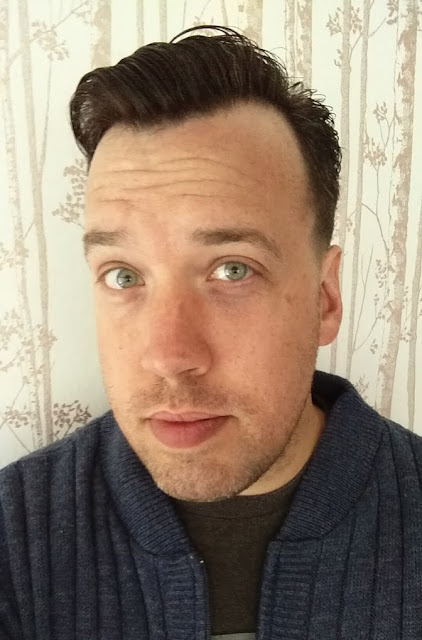
An interview with Mark Ludwig: Vice-President and Director of Development for CurlyRed
Published: May 18, 2017

 |
| Here's Mark, rocking a new 'do and favorite “old man sweater.” |
We wanted to share a little more of Mark's story with you: his training, passions, and career moves that has led him to become CurlyRed's “web guru.” Mark has a very unique approach to online design and development, and brings his joy and silliness to the CurlyRed office.
-
What did you go to school for? What kind of artist did you think you would be when you graduated?
I went to school for graphic design, and about two years into my program I met the head of the Industrial Design department (that was brand new), who convinced me to pursue Industrial Design as well. So not initially planning on that, I became a double major. -
How did you end up in web design and development?
I always knew I was going to be a designer, I just didn’t know in what particular field. There was a limitation of knowledge on what options were available. I just assumed I would be working in-house somewhere. -
Why is the digital design space such a good fit for your personality?
Balancing the design and the development really allows me to use both sides of my brain, in a way that strictly choosing one or the other wouldn’t have allowed. As I’ve gotten older, I’ve become more interested in mathematics and problem-solving. Web development specifically speaks to that desire. -
What was the hardest thing you had to learn in regards to web design?
Two things. 1) There are so many different technologies that each have their own nuances that make developing a challenge. 2) In web development, it’s more about the actual function in some cases, as opposed to just looking nice. Regardless of how it looks, it has to work. -
What class do you wish you would have taken in college? Why?I wish it would have been a requirement to take both marketing and computer science. For the marketing, coming out of school, you have really no preparation for the business side of design. And even a basic knowledge of marketing principles and practices would have greatly helped.
For computer science, it would have broadened my understanding of various coding languages that could have led me down other paths. -
You went from being an in-house marketing/designer to running a creative wing of an ad agency. What was the biggest difference between those two work environments? What are the pros and cons of both?
Biggest differences were variation of work from day to day was stronger in an agency and our clients were the final decision-makers. For in-house design, the only client is the owner of the company. Time was another factor that was a big difference. Time expectations were more demanding in an agency, and there was more lenience with timing at my in-house position. -
How long have you been working with CurlyRed?
Back in 2011, I worked officially for CurlyRed one day a week. But even before then, I was supporting CurlyRed with client and in-house work since the beginning. Just this February, I officially came on full-time. -
Why did working full-time at CurlyRed make sense to you?
I strongly believe in Kendall’s vision for the company, and her desire to expose all businesses to good design, regardless of size. And more than any other company I’ve ever worked for, I align myself with that vision. -
What is it about your current position that you enjoy most?
Getting to work with my wife everyday, helping her to grow her business and passion. I also love providing elegant design solutions for our clients and the positive response we get when we’ve really nailed it. -
What is your current approach to a new web design/development project?
Most importantly, understanding exactly what a client needs and providing our knowledge of current design trends and practices to not only meet their needs, but push their design in a direction that puts them on the forefront in their industry. -
Speaking of trends, which ones are you seeing pop up? What trends need to die already?
Clean, flat design is something that feels like it’s here to stay. From websites to apps, design has simplified itself to put the information first and make the user experience as straight-forward as possible. With that, there’s less emphasis on making “realistic” UIs and getting away from gradients, complex photographic imagery and multiple font faces. In most cases, the best design in the world is the most clean and simple, removing all of the clutter. - Why should someone choose CurlyRed for their new website?
I think one of the many things we do well is to truly understand the tone and voice of our clients, and create design solutions that reflect them. It’s very easy and inexpensive to find off the shelf templates that can fulfill the need of a website or logo, but in most cases those do not reflect who the client is and what audience they are targeting. With that being said, that is the main reason why we choose to make everything 100% custom. This allows us to have a more intimate knowledge of our client because of the dialogue we have, and enables us to deliver exactly what they want.
And we’re the best. Boom.
____________
Thanks, Mark! We love that all of our clients now benefit from your skills and expertise. Do you need help with your next web, branding or print design project? Contact us today, we're ready to help.
Back to Blog

 Categories:
Categories: